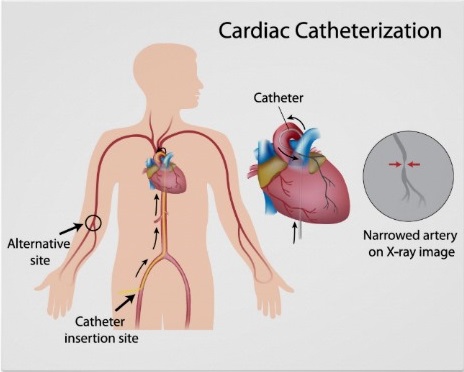 New Health Guide
New Health Guide
Heart catheterization involves the insertion of tubes, also known as catheters, into the main vein of the groin area called the femoral artery or in the main vein of the arm called the radial artery. During the procedure, a small defect or puncture is often made in the vein and when the tubes are removed, blood may leak. However, there are ways to prevent bleeding from the puncture, such as:
Both methods are only temporary fixes to the artery, but over the next several days after the procedure, the area will grow stronger and heal. This is part of the heart catheterization recovery.

Heart catheterization recovery starts as soon as your procedure is complete and you are relocated to the hospital recovery room. The plastic sheath covering the insertion site into your artery is removed shortly after, unless you are required to continue taking blood-thinning drugs.
As soon as deemed safe, you will be moved to a regular hospital room. Once there, the tube or catheter is removed. In order to prevent bleeding, pressure will be applied to the insertion site by the nurse. Depending on the location, you may have to lie down flat for a couple hours so the artery can heal.
Even though you can drink and eat after your heart catheterization, you may not be able to go home right away. Depending on other factors and your overall condition, you may have to stay overnight or even a few days. However, often individuals can go home the same day.
For most people, the recovery process is very simple. Activity will be very limited the first day and then somewhat limited after that. It will take several weeks or more to completely heal, so care will need to be taken to prevent injury to the area.
It is typical for the tube insertion site to be sore for a couple of days after the procedure. This is normal during the heart catheterization recovery time. Right after the procedure, you will most likely be given a mild narcotic to ease the pain. Once home, you can take acetaminophen or aspirin. If your pain persists, the area becomes inflamed or red, or you develop a fever, you should call your doctor right away.
Do not be alarmed if you develop a bruise at the insertion site after the procedure. It is caused by blood that flowed to the area during the heart catheterization, not bleeding afterwards. It may catch you off guard at first, because often the bruised area can be quite large. If the insertion site was in the groin, the bruise may extend past your knee or further. It may even grow larger over time. Do not let it worry you. It will fade over time, finally disappearing completely.
Very often a small lump will form at the insertion spot. This is a common occurrence, caused by inflammation and trauma to the site. Avoid touching the lump, as this may cause irritation. Over the next couple of weeks or so, it will shrink and disappear.
During heart catheterization recovery, you will need to care for the catheter insertion site. When you are released from the hospital, there will be a bandage covering the area.
Your doctor will instruct you on the types of activities you can perform and when you can resume your normal schedule. Typically, you will need to rest the first couple of day after you are released from the hospital. It is normal to feel tired and worn out after a heart catheterization procedure. Walk near or around your house, not out and about as you will need your rest. For femoral catheters, take care to:
For radial cardiac catheters, take note to:
You should drink at least eight glasses of water or clear liquid to clear your system of any contrast dyes or materials.
You underwent a heart catheterization procedure for a reason: there was something wrong with your cardiac system. This is a wakeup call to follow a healthy heart lifestyle. To achieve this, you need to eat a healthy diet, quit unhealthy habits like smoking or drinking, take your regular medications as directed and follow the appointment schedule given by your doctor.
You should contact your doctor or seek medical advice right away if any of the following occur: